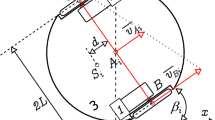Abstract
This paper presents a framework for decentralized control of self-organizing swarm systems based on the artificial potential functions (APFs). In this scheme, multiple agents in a swarm self-organize to flock and achieve formation control through attractive and repulsive forces among themselves using APFs. In particular, this paper presents a set of analytical guidelines for designing potential functions to avoid local minima for a number of representative scenarios. Specifically the following cases are addressed: 1) A non-reachable goal problem (a case that the potential of the goal is overwhelmed by the potential of an obstacle, 2) an obstacle collision problem (a case that the potential of the obstacle is overwhelmed by the potential of the goal), 3) an obstacle collision problem in swarm (a case that the potential of the obstacle is overwhelmed by potential of other robots in a group formation) and 4) an inter-robot collision problem (a case that the potential of the robot in a formation is overwhelmed by potential of the goal). The simulation results showed that the proposed scheme can effectively construct a self-organized swarm system with the capability of group formation, navigation and migration in the presence of obstacles.
Similar content being viewed by others
References
Balch, T., Hybinette, M.: Behavior-based coordination of large-scale robot formations. Proc. Fourth Int. Conf. on Multi Agent Systems, pp. 363–364, (2000)
Baras, J.S., Tan, X., Hovareshti, P.: Decentralized control of autonomous vehicles. 42nd IEEE Conference on Decision and Control. Maui, Hawaii, pp. 1532–1537, (2003)
Beni, G., Liang, P.: Pattern reconfiguration in swarms-convergence of a distributed asynchronous and bounded interative algorithm. IEEE Trans. Robot. Autom. 12, 485–490 (1996)
Chuang, J.H., Ahuja, N.: An analytically tractable potential field model of free space and its application in obstacle avoidance. IEEE Trans. Syst. Man Cybern., B 28, 729–736 (1998)
Clark, M.R., Anderson, G.T.: Coupled oscillator control of autonomous mobile robots. Auton. Robots 9(2), 189–198 (2000)
Dudenhoeffer, D., Jones, M.: A formation behavior for large-scale micro-robot force deployment. Proc. of the 2000 Winter Simulation Conf., pp. 972–982, (2000)
Gazi, V., Passino, K.M.: Stability analysis of swarms. IEEE Trans. Automat. Contr. 48(4), 692–697 (2003)
Ge, S.S., Cui, Y.J.: Dynamic motion planning for mobile robots using potential field method. Auton. Robots 13(3), 207–222 (2002)
Ge, S.S., Cui, Y.J.: New potential functions for mobile robot path planning. IEEE Trans. Robot. Autom. 16(5), 615–620 (2000)
Khatib, O.: Real-time obstacle avoidance for manipulators and mobile robots. Int. J. Rob. Res. 5(1), 90–98 (1986)
Koren, Y., Borenstein, J.: Potential field methods and their inherent limitations for mobile robot navigation. Proc. of the IEEE int. Conf. on Robotics & Automation, pp. 1398–1404, (1991)
Olfati-Saber, R., Murray, R.M.: Distributed cooperative control of multiple vehicle formations using structural potential functions. In IFAC World Congress, Barcelona, Spain, (2002). http://www.cds.caltech.edu/~olfati/papers/ifac02/ifac02_ros_rmm.pdf
Parker, L.E.: Cooperative robotics for multi-target observation. Intelligent Automation and Soft Computing, special issue on Robotics Research at Oak Ridge National Laboratory 5(1), 5–19 (1999)
Prahlad, V., Kay, C., Wang, M.: Evolutionary artificial potential fields and their application in real time robot path planning. Congress of Evolutionary Computation (CEC2000), pp. 256–263. San Diego, California, (2000)
Reynolds, C.W.: An evolved vision-based behavioral model of coordinated group motion. In: Meyer, J.-A., Roiblat, H.L., Wilson, S. (eds.) From Animals to Animals 2, pp 384–392. MIT (1992)
Reynolds, C.W.: Flocks, herds and schools: A distributed behavioral model. Comput. Graph. 21(4), 25–34 (1987)
Rimon, E., Koditschek, D.E.: Exact robot navigation using artificial potential functions. IEEE Trans. Robot. Autom. 8(5), 501–518 (1992)
Spears, W., Spears, D., Hamann, J., Heil, R.: Distributed, physics-based control of swarms of vehicles. Auton. Robots 17(2–3), 137–162 (2004)
The Math Works Inc.: The Student Edition of MATLAB. Prentice-Hall, New Jersey (1992)
Werger, B.B., Mataric, M.J.: Broadcast of local eligibility for multi-target observation. Proc. on Distributed Autonomous Robotic Systems, pp. 347–356, (2000)
Unsal, C., Bay, J.S.: Spatial self-organization in large populations of mobile robots. IEEE International Symposium on Intelligent Control, Columbus, Ohio, August, pp. 249–254, (1994). http://www.cs.cmu.edu/~unsal/publications/spatial.html
Author information
Authors and Affiliations
Corresponding author
Additional information
Category (5) – Intelligent Systems/Intelligent Control/Fuzzy Control/Prosthetics/Robot Motion Planning
Rights and permissions
About this article
Cite this article
Kim, D., Wang, H. & Shin, S. Decentralized Control of Autonomous Swarm Systems Using Artificial Potential Functions: Analytical Design Guidelines. J Intell Robot Syst 45, 369–394 (2006). https://doi.org/10.1007/s10846-006-9050-8
Received:
Accepted:
Published:
Issue Date:
DOI: https://doi.org/10.1007/s10846-006-9050-8




